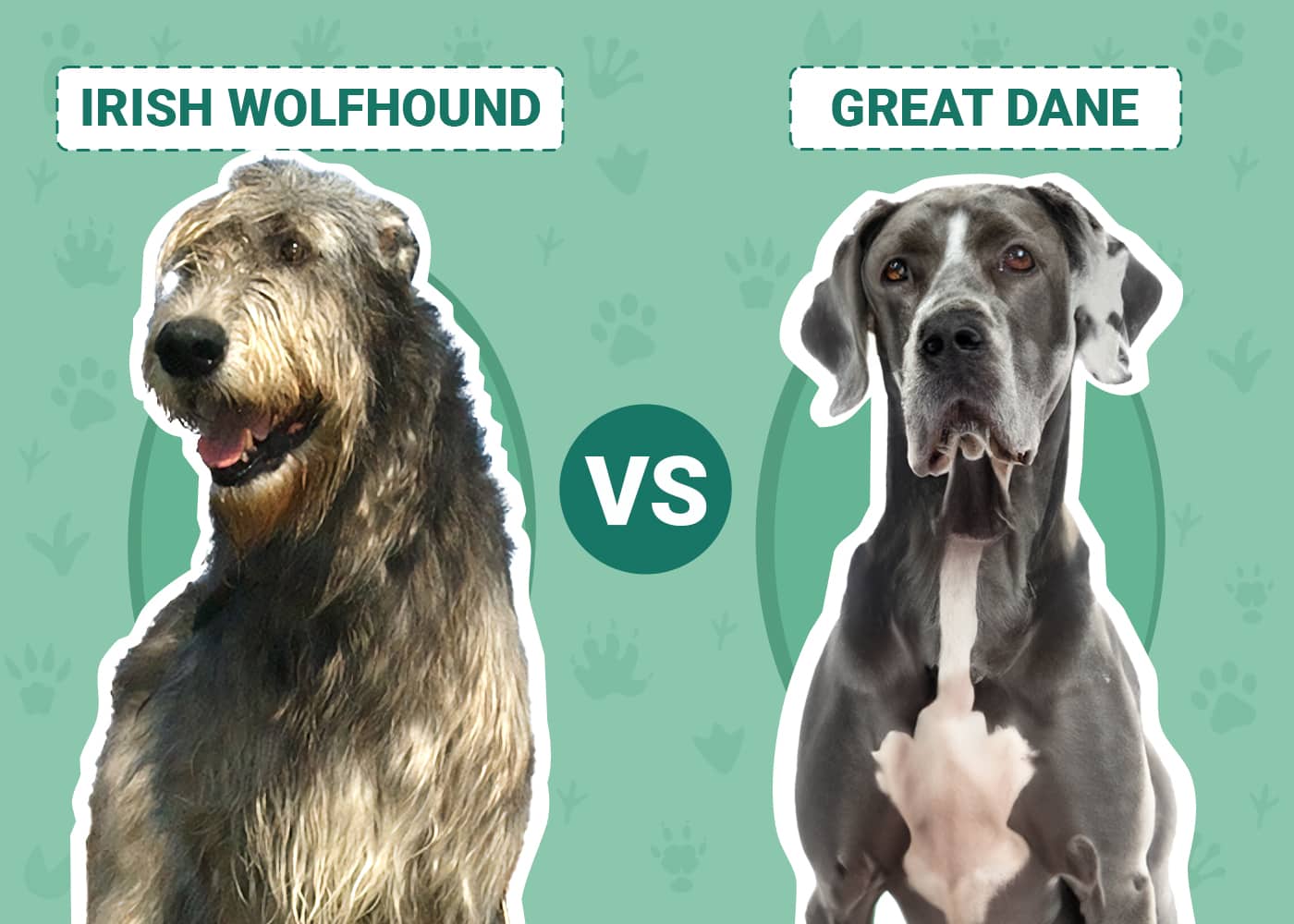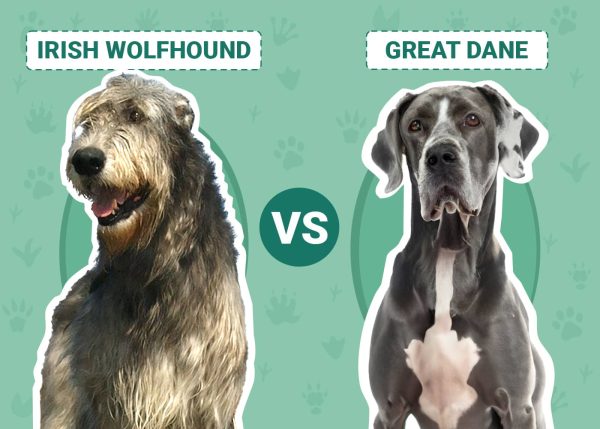Click to Skip Ahead
The Irish Wolfhound and the Great Dane are two of the largest dog breeds in the world. These dogs can grow to massive sizes, but can also grow on our hearts. If you’ve decided that bringing a big dog into your home is a must, you may find yourself trying to decide which of these breeds is best suited for you. While both dogs come from amazing backgrounds and have lots of similarities, they are also quite different.
Let’s take a look at those differences below to help you decide whether the Irish Wolfhound or Great Dane will become your new best friend and family member.

Visual Differences
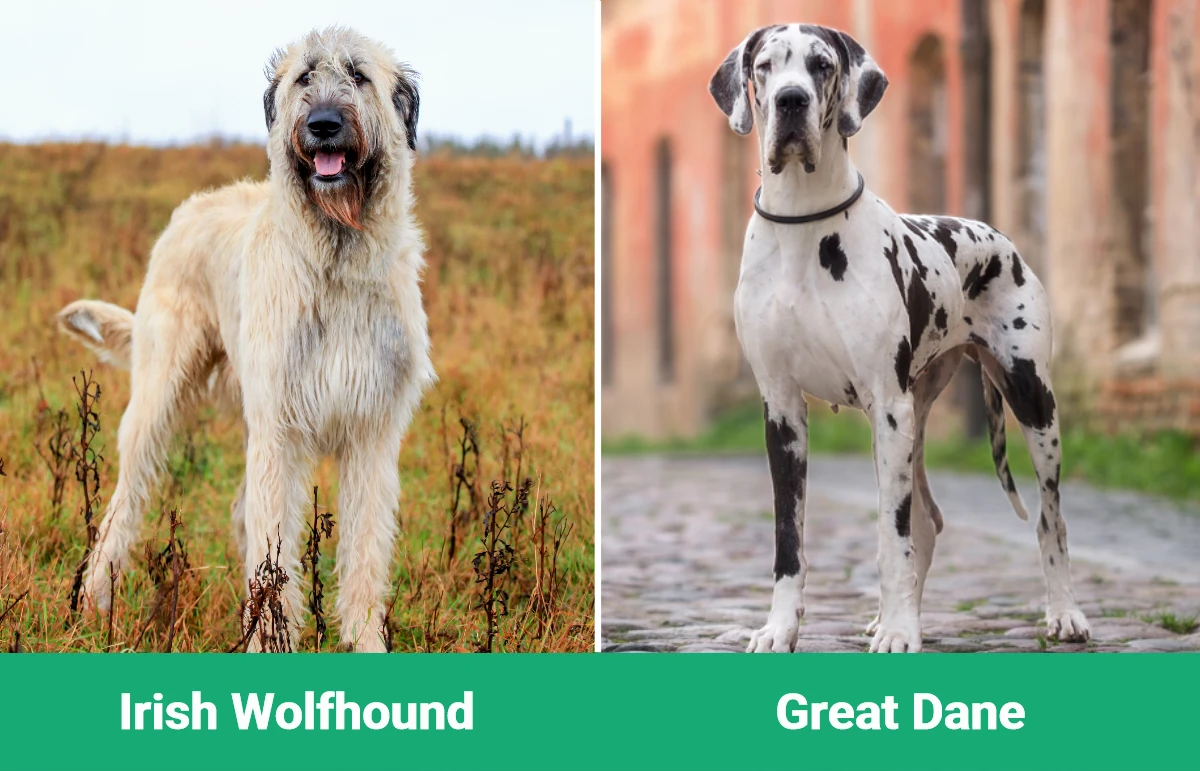
At a Glance
- Average height (adult): 32–35 inches
- Average weight (adult): 115–180 pounds
- Lifespan: 6–8 years
- Exercise: 40+ minutes a day
- Grooming needs: Moderate
- Family-friendly: Yes
- Other pet-friendly: Often
- Trainability: Intelligent and loyal
- Average height (adult): 26–34 inches
- Average weight (adult): 100–200 pounds
- Lifespan: 7–10 years
- Exercise: 45+ minutes a day
- Grooming needs: Minimal
- Family-friendly: Yes
- Other pet-friendly: Yes
- Trainability: Intelligent, loving, and eager to please
Irish Wolfhound Overview

Personality/Character
Originally bred for hunting large game like boar and deer, the Irish Wolfhound is a sighthound that also aided in helping their families fight off wolf attacks. These dogs are quite loyal so they immediately wanted to protect their humans by using their size and abilities to detour the wolves. While the days of hunting and fighting are mostly gone, the Irish Wolfhound is now best known as a companion animal.
These dogs love spending time with their people and do their best when they live inside the home so they can be close to their owners and families.
Although they are big in size, the Irish Wolfhound prefers to be with others. They don’t do well in homes where their owners are gone for several hours throughout the day. In most situations, you’ll find that they get along well with other dogs and cats if socialized at a young age. However, due to their strong prey drive, it is best to avoid leaving your Irish Wolfhound alone with small pets.
Training
Irish Wolfhounds are intelligent dogs which makes training fairly easy. However, they are quite sensitive. Harsh tones can be harmful to their training. Instead, they do best with lots of patience and encouragement. If you are training your pet yourself and feel a bit agitated, it is best to walk away. If you yell or raise your voice, you could easily ruin the training session and set back the progress you’ve made with your Irish Wolfhound.
Housebreaking or crate training an Irish Wolfhound is quite easy. These dogs do well with command words but keep in mind, they are quite strong. When you have them out on the leash they pull you or even lunge if they see small animals. This is common due to their high prey drive. It’s best to allow adults to handle the walking of this large animal to avoid issues with children being dragged around.
Exercise
The Irish Wolfhound isn’t the kind of dog you’ll find sprinting around your yard for hours a day. Normally, they do well with 40 minutes of exercise per day and are fans of simple walks. You will notice, however, from time to time that their prey drive does kick in. This may have your Wolfhound chasing small animals in the backyard.
To avoid issues with these big dogs wandering, having a fenced area for them to exercise in is a great option. With this large dog breed having issues with their joints, it is best to avoid too much stimulation when allowing them to exercise.
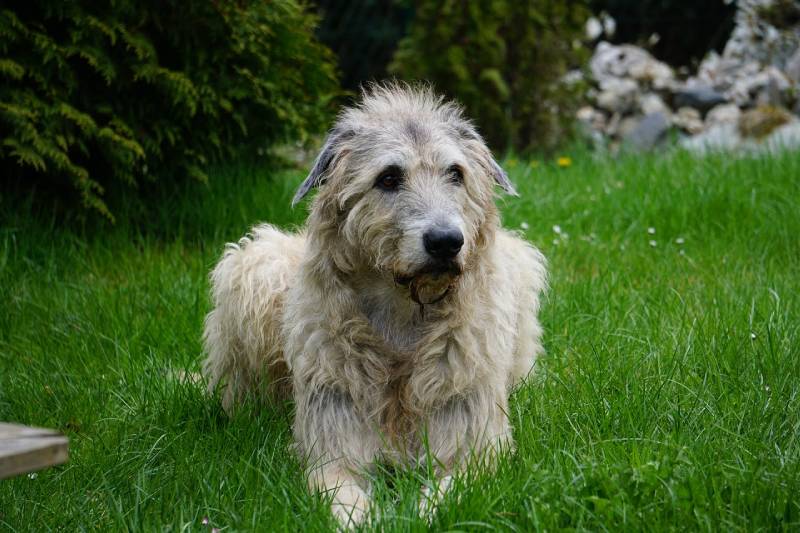
Health & Care
Overall, Irish Wolfhounds are considered a fairly healthy dog breed even though they have relatively short lifespans. The most common issues they suffer from are those that plague large dog breeds like hip dysplasia. You’ll also need to be aware if you take your Irish Wolfhound to the veterinarian for any procedure where they will need to use anesthesia. Sighthounds are sensitive to anesthesia and need the care of veterinarians who are aware of these types of problems.
The grooming needs of the Irish Wolfhound are fairly moderate. They have thick, double coats that are known to shed. Unlike some dogs, however, they do not blow their coats seasonally. This makes dealing with this breed’s shedding much easier. Using pin brushes and combs once a week will help keep your Irish Wolfhounds looking their best with the least amount of tangles.
Bathing should only be done when needed for this dog breed. If you notice an odor or dirt on their coats, it’s time for a trip to the tub. You will want to keep their nails properly trimmed and teeth cleaned regularly. You’ll also find that this breed’s floppy ears can suffer from infections if not kept clean and dry.
Suitable For:
Irish Wolfhounds make great pets for most families, but their size must be a consideration before bringing this dog breed home. With such a large dog breed, you’ll need an area that can accommodate their needs. This is why apartments or small homes are frowned upon when it comes to housing this breed. They are large dogs with big appetites. An Irish Wolfhound can easily snatch a snack off your kitchen table if you aren’t paying attention so be prepared to keep food properly stored away when these dogs are in the home.
While Irish Wolfhounds do great with people and most pets, they are big and powerful. This makes them a bit of a concern when it comes to small children. It is best if only adults and older children are in the home with these dogs. Little kids can easily get knocked down or hurt without these large dogs meaning to cause any harm.

Great Dane Overview

Personality / Character
Great Danes are an easy-going family dog that is happy simply lounging with their owners. Similar to the Irish Wolfhound, these dogs were originally bred to hunt large game, namely wild boar. Throughout the years, however, those hunting traits were bred out. This makes them more trusted around smaller children and animals than the Wolfhound as they don’t have as fierce of a prey drive or the same high energy.
Today’s Great Danes are mild-mannered giants that will do well in any size home. However, their exercise needs should be met to keep them healthy. These dogs do like the simple life. If you have a large backyard or park nearby, they’ll love taking a stroll with you. When you aren’t out and about, they don’t mind sharing the sofa, even if they take up the most room.
Training
You’ll find that training a Great Dane is often easier than working with an Irish Wolfhound. This comes from the Great Dane’s eagerness to please their owners. These dogs are quite attentive and will listen to commands well. Early socialization is always suggested, but the Great Dane normally does well in any situation. They get along well with small animals and other pets, as well as with children. Due to their gentile natures, you’ll most likely need to work with children on how best to interact with these gentle giants.
Great Danes aren’t known to be heavy barkers, but when they do bark, it’s noticeable. One of the most important training aspects to tackle is controlling that bark. Helping your Great Dane learn how to stop barking on command may save the entire family’s eardrums from time to time.
Exercise
Great Danes aren’t big on exercise. While an adult needs at least 45 minutes of exercise a day, they enjoy getting this in by taking walks with their owners or bouncing around the backyard. Considering their ease of hanging out with the family, you’ll find that you may need to motivate your Great Dane to get their time in each day.
You’ll also need to be mindful, just like with the Wolfhound, of strenuous activities that can be hard on the joints.
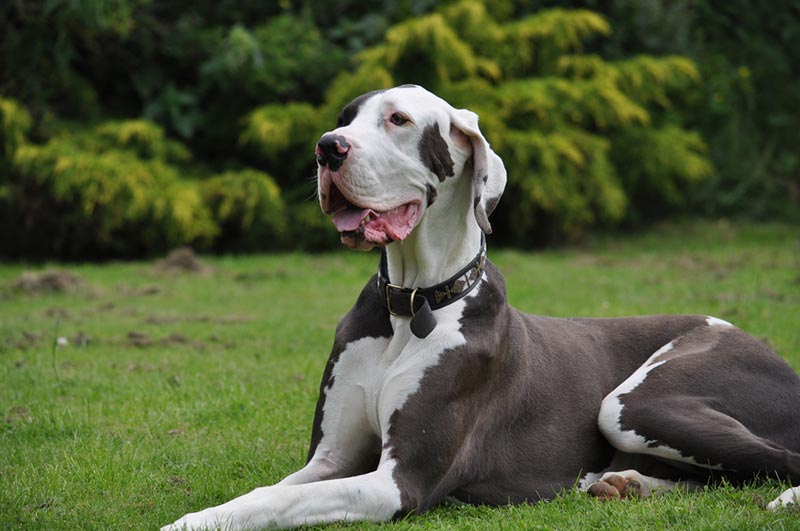
Health & Care
The Great Dane is also a fairly healthy dog like the Irish Wolfhound, but you’ll notice they have a longer lifespan than the Wolfhound. Joint issues are one of the main worries when it comes to these large dogs. However, it should be noted that any owner of a Great Dane should be aware of the symptoms of bloat, as it is known as the number one fatal health condition affecting this breed. This serious condition can be fatal if not noticed and properly treated.
Great Danes have minimal grooming needs. They are not heavy shedders but still should be brushed once per week to keep their coats clean and nice. Like with any dog, you should keep your Great Dane’s teeth cleaned regularly and trim its nails often. You’ll also find that Great Danes with uncropped ears tend to get ear infections. To prevent this, whether cropped or uncropped, keep your pet’s ears well-cleaned.
Suitable For:
Great Danes are an ideal family pet. Their gentle nature makes them better around children than the Irish Wolfhound. However, their sheer size shouldn’t be overlooked. These dogs may do well in small homes or apartments, but to truly be happy a large dog needs room. If you have space for a Great Dane, they will easily fit into your home and family.
Which Breed Is Right For You?
Both the Irish Wolfhound and Great Dane are large dog breeds with big needs. If you plan on bringing one of these dog breeds into your home, you must be prepared for the overall expense. Both of these breeds will eat more, will need bigger toys, and will require larger, more expensive pet beds and other items. Understanding that financially supporting these large dogs should factor into whether they are right for your family’s situation.
The Irish Wolfhound is an energetic, large dog with a prey drive that can kick in at a moment’s notice. For these reasons, homes with small children may not be the best option. Older kids and experienced dog owners will do well with this breed. You must also have the time to dedicate to the Wolfhound as they aren’t fans of being alone.
Great Danes are a laid-back breed of dog that does well in almost any situation. If you have space for these gentle giants, they’ll fit in great with kids of all sizes, other pets, and even small animals. A Great Dane will be loyal, loving, and quick to keep you happy.

Conclusion
As you can see, each of these dog breeds brings something unique to the table. Before choosing the breed that is right for you, determine your situation and decide what you can offer the dog. Once that’s done, you’ll see that both of these breeds can make amazing pets when taken into a home that is suited to their personalities and needs.
See Also:
- Cane Corso Irish Wolfhound Mix: Guide, Pictures, Care & More
- Irish Dane Dog Breed: Pictures, Guide, Info, Care & More
Featured Image Credit: Top – DragoNika, Shutterstock | Bottom – BIGANDT.COM, Shutterstock

